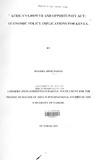| dc.description.abstract | The study examines the policy areas that Kenya needs to improve on in order to take full
advantage of Africa's Growth and Opportunity Act (AGOA). The Act, as a new US trade
and policy towards Sub-Saharan Africa, provides liberal conditions to Africa's exports to
the United States. The situation is that Africa's products would enter the US markets
under duty free conditions, subject to the rules of eligibility being met by the beneficiary
countries.
Kenya is one of the countries in Africa which is targeted by the Act. It suffers from the
economic problems facing the continent, namely indebtedness, low export earnings,
dependency on development assistance and low investment inflows among others. These
are partly caused by weak internal policies and also by external factors. The consequence
is widespread poverty among the population as a result of decline in economic growth
and performance.
In Chapter One, the background to AGOA is discussed and it is shown that the
economies of Africa are characterized by myriad problems embodied in Kenya. It is
particularly shown that trade policies of both the US and Africa to date are protectionist.
African states also continue to suffer because the sectors, namely agriculture and
manufacturing utilize outdated technology hence need to modernize them to be able to
compete. The study also reveals that there is little integration of the sectors hence the
linkages effects that generate economic growth cannot be exploited. In the circumstances that the economies of Africa in general and Kenya in particular
experience downward trend due to some of the conditions referred to earlier,
development assistance and the politics of debt serving become the order of the day.
Since the aim of the AGO A is to promote trade and not aid as the US is convinced that
trade and investments would sustain the economies, the study therefore utilized
international trade development assistance, debt, foreign direct investment paradigms to
guide the analysis. These are found to be relevant to the research area since AGO A main
components deal with these issues. .
The literature review explicates that the US economic policy towards Africa is defined in
strategic terms only. In which case, US views Africa as a source of vital raw materials
namely; oil and minerals. Trade, investment and aid are very small as compared to other
continents. Those African states which process the oil and minerals critical to the US are
the leading beneficiaries of US trade, investment and aid.
Chapter Four is a critical treatment of the Act. Privatisation of public enterprises, which
is one of the conditions African governments are expected to be committed to
implementing is analysed. Its pros and cons are considered, however it is viewed that
there should be sufficient evaluation before the enterprises are sold. The provision on
textile and apparel is found to suggest that the US is still protectionist, showing gradual
liberalization. Most important however is the fact that the limitless duty free market is
not as is purported. AGO A is as limiting as the past regimes since the prevailing
preferential treatment is bilaterally negotiated but can suffer from unilateral (US) ban. Findings on policy implications for Kenya are that it has made a considerable effort to
improve its trade in textile with the US within two years of gaining eligibility. It has also
realized minimal impact in investment and linkage effects brought about AGO A.
However the incentive structure is far inadequate in relation to infrastructure, fiscal
policies and regulatory frameworks. All have led to high costs of productions and to the
uncompetitiveness of its products in the markets. A major area of concern is the state of
the collapsed cotton industry which the study shows is still crippled. Kenya therefore
needs to urgently develop a strategy and favourable conditions to revive the industry
within the remaining two years the Act allows imports of duty free cotton yam from
AGOA beneficiary country. Otherwise reliance on imports would adversely affect her
production and trade in the same commodity. | en |

